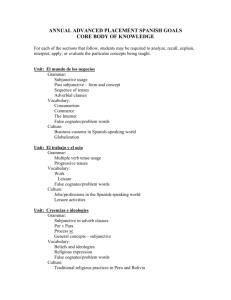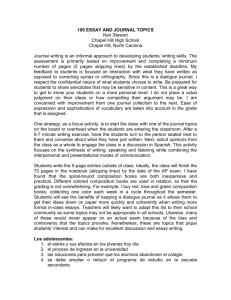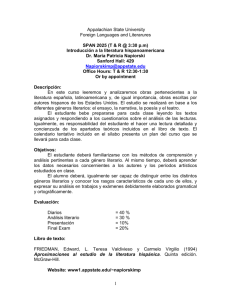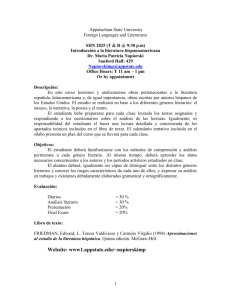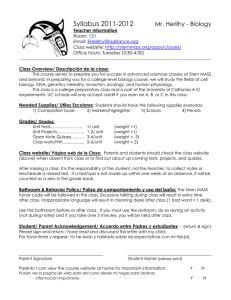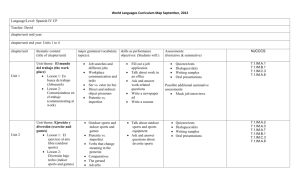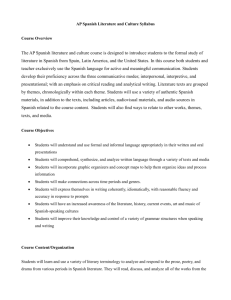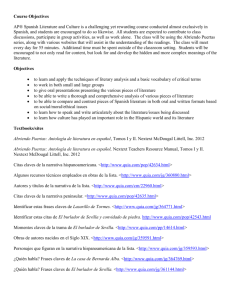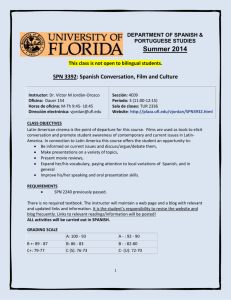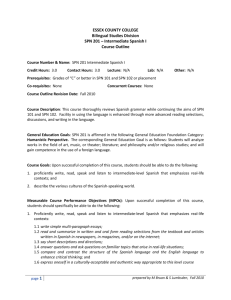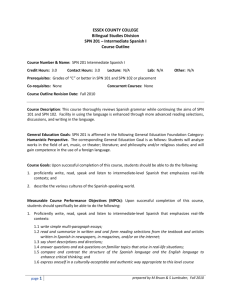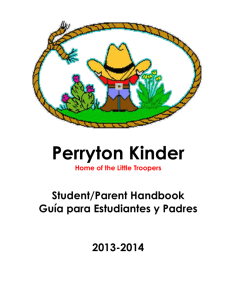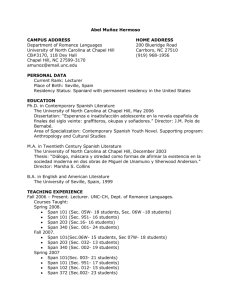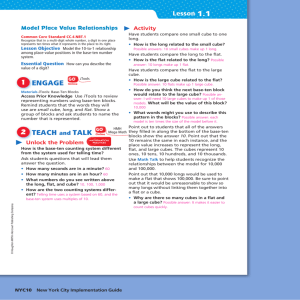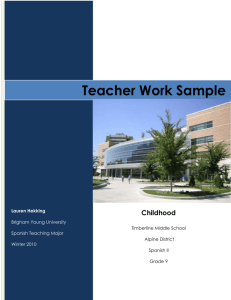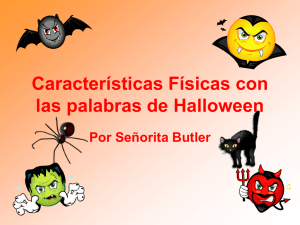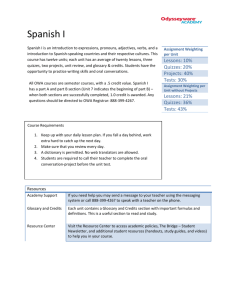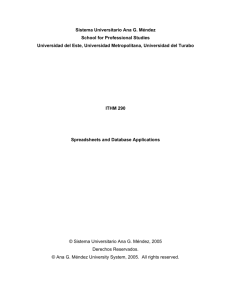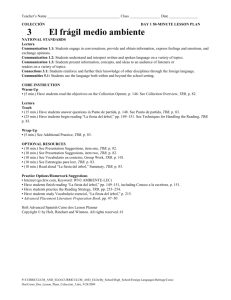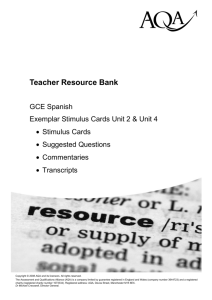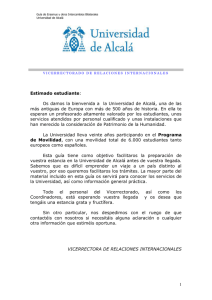Course Description
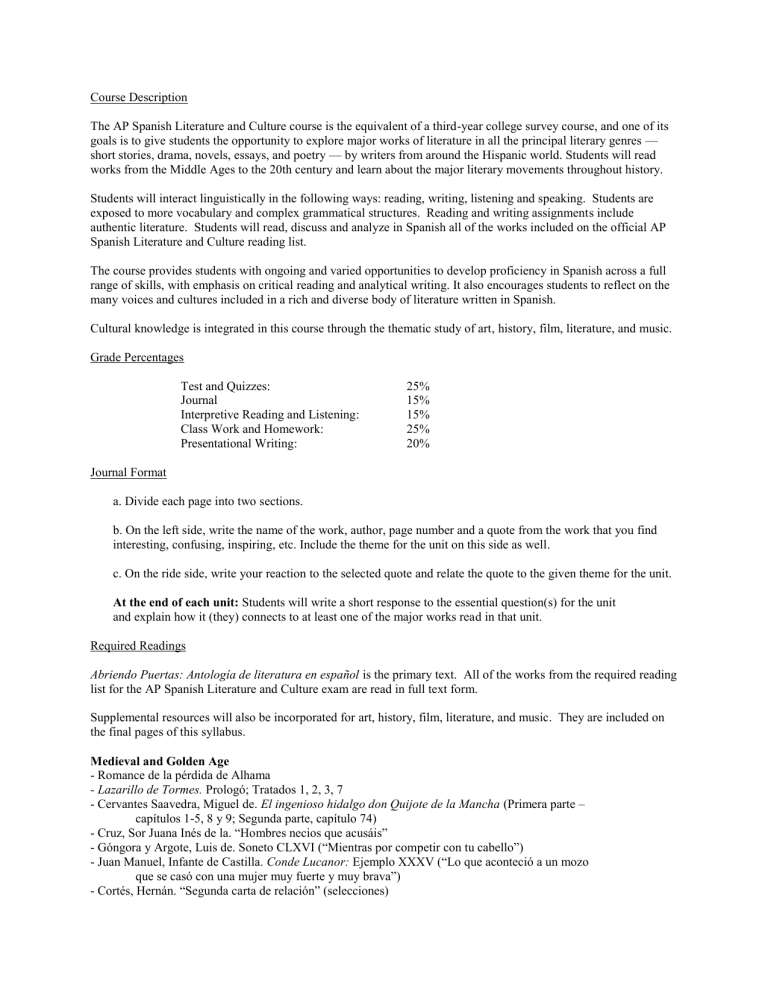
Course Description
The AP Spanish Literature and Culture course is the equivalent of a third-year college survey course, and one of its goals is to give students the opportunity to explore major works of literature in all the principal literary genres — short stories, drama, novels, essays, and poetry — by writers from around the Hispanic world. Students will read works from the Middle Ages to the 20th century and learn about the major literary movements throughout history.
Students will interact linguistically in the following ways: reading, writing, listening and speaking. Students are exposed to more vocabulary and complex grammatical structures. Reading and writing assignments include authentic literature. Students will read, discuss and analyze in Spanish all of the works included on the official AP
Spanish Literature and Culture reading list.
The course provides students with ongoing and varied opportunities to develop proficiency in Spanish across a full range of skills, with emphasis on critical reading and analytical writing. It also encourages students to reflect on the many voices and cultures included in a rich and diverse body of literature written in Spanish.
Cultural knowledge is integrated in this course through the thematic study of art, history, film, literature, and music.
Grade Percentages
Test and Quizzes:
Journal
Interpretive Reading and Listening:
Class Work and Homework:
Presentational Writing:
Journal Format a. Divide each page into two sections.
25%
15%
15%
25%
20% b. On the left side, write the name of the work, author, page number and a quote from the work that you find interesting, confusing, inspiring, etc. Include the theme for the unit on this side as well. c. On the ride side, write your reaction to the selected quote and relate the quote to the given theme for the unit.
At the end of each unit: Students will write a short response to the essential question(s) for the unit and explain how it (they) connects to at least one of the major works read in that unit.
Required Readings
Abriendo Puertas: Antología de literatura en español is the primary text. All of the works from the required reading list for the AP Spanish Literature and Culture exam are read in full text form.
Supplemental resources will also be incorporated for art, history, film, literature, and music. They are included on the final pages of this syllabus.
Medieval and Golden Age
- Romance de la pérdida de Alhama
- Lazarillo de Tormes. Prologó; Tratados 1, 2, 3, 7
- Cervantes Saavedra, Miguel de. El ingenioso hidalgo don Quijote de la Mancha (Primera parte – capítulos 1-5, 8 y 9; Segunda parte, capítulo 74)
- Cruz, Sor Juana Inés de la. “Hombres necios que acusáis”
- Góngora y Argote, Luis de. Soneto CLXVI (“Mientras por competir con tu cabello”)
- Juan Manuel, Infante de Castilla. Conde Lucanor: Ejemplo XXXV (“Lo que aconteció a un mozo que se casó con una mujer muy fuerte y muy brava”)
- Cortés, Hernán. “Segunda carta de relación” (selecciones)
- Quevedo y Villegas, Francisco de. Salmo XVII (“Miré los muros de la patria mía”)
- Téllez, Gabriel (Tirso de Molina). El burlador de Sevilla y convidado de piedra
- Vega, Garcilaso de la. Soneto XXIII (“En tanto que de rosa y de azucena”)
The 19th Century
- Bécquer, Gustavo Adolfo. Rima LIII (“Volverán las oscuras golondrinas”)
- Darío, Rubén. “A Roosevelt”
- Heredia, José María. “En una tempestad”
- Martí, José. “Nuestra América”
- Pardo Bazán, Emilia. “Las medias rojas”
The 20th Century
- Allende, Isabel. “Dos palabras”
- Borges, Jorge Luis. “El sur” y “Borges y yo”
- Burgos, Julia de. “A Julia de Burgos”
- Cortázar, Julio. “La noche boca arriba”
- Dragún, Osvaldo.
El hombre que se convirtió en perro
- Fuentes, Carlos. “Chac Mool”
- León-Portilla, Miguel. Visión de los vencidos (dos secciones: “Los presagios, según los informantes de
Sahagún” y “Se ha perdido el pueblo mexicatl”)
- García Lorca, Federico. La casa de Bernarda Alba y “Prendimiento de Antoñito el Camborio en el camino de Sevilla”
- García Márquez, Gabriel. “El ahogado más hermoso del mundo” y “La siesta del martes”
- Guillen, Nicolás. “Balada de los dos abuelos”
- Machado, Antonio. “He andado muchos caminos”
- Montero, Rosa. “Como la vida misma”
- Morejón, Nancy. “Mujer negra”
- Neruda, Pablo. “Walking around”
- Quiroga, Horacio. “El hijo”
- Tomás Rivera. … y se lo tragó la tierra (dos capítulos “….y no se lo tragó la tierra” y “La noche buena”)
- Rulfo, Juan. “No oyes ladrar los perros”
- Storni, Alfonsina. “Peso ancestral”
- Ulibarrí, Sabine R. “Mi caballo mago”
- Unamuno y Jugo, Miguel de. San Manuel Bueno, mártir
Pre-Course Required Reading
Given the volumes of reading required for this course, students must complete the following readings, and their accompanying audio and written assignments, during the summer prior to taking the course:
- Lazarillo de Tormes. Prologó; Tratados 1, 2, 3, 7
- León-Portilla, Miguel. Visión de los vencidos (dos secciones: “Los presagios, según los informantes de
Sahagún” y “Se ha perdido el pueblo mexicatl”)
- Montero, Rosa. “Como la vida misma”
These assignments will be reviewed during the thematic unit, but in lesser detail than those that are being newly read.
Organization and Themes
The course will be taught as a series of thematic units. The following is the anticipated schedule of instruction and material for the students. Tests, quizzes and homework assignments will be scheduled as the course progresses.
Unit 1: La Edad Media (estimated time: 1 week)
Themes: - Las sociedades en contacto
- La construcción del género
Contexts: - The three dominant cultures in medieval Spain
- The oral tradition that led to the romances
- The role of a “theocentric” society in the development of medieval literature
Essential Question: - How does medieval literature reveal the cultural practices and perspectives of the people who inhabited the Iberian Peninsula?
Readings: - Anónimo, “Romance de la pérdida de Alhama
- Don Juan Manuel, El Conde Lucanor , Ejemplo XXXV
Unit 2: El encuentro de dos mundos (estimated time: 8 days)
- sociedades en contacto Themes:
Contexts: - The Spanish conquest of the Americas and the expansion of the Empire
Essential Question:
Themes:
- How were the historical events of the Spanish conquest viewed by the indigenous peoples and their conquerors?
Readings: - Cortés, “Segunda carta de relación”
- León-Portilla, Visión de los vencidos (“Los presagios, según los informants de
Sahagún” y “Se ha perdido el pueblo mexica”)
Unit 3: Temas poéticos del Renacimiento y del Barroco (estimated time: 2 weeks)
- El tiempo y el espacio
- La construcción del género
Contexts: - The Renaissance attitude toward art and man
- The Baroque attitude toward art and man
- The role of women in Siglo de Oro Spain and the colonies
Essential Questions: - What does Siglo de Oro literature reveal about the Spanish perspective toward life and death?
- What views about male and female roles in society are conveyed in Renaissance and
Baroque poetry?
Readings: - Garcilaso, Soneto XXII
- Góngora, Soneto CLXVI
- Quevedo, Salmo XVII
- Sor Juana, “Hombres necios que acusáis”
Unit 4: Relaciones sociales en el Siglo de Oro (estimated time: 3 weeks)
Themes: - Las relaciones interpersonales
- La construcción del género
Contexts: - The power of the Catholic Church in post-Reconquista Spain
- The effect of Spain’s imperial designs on its citizens and their everyday lives
- The role of honor in Spanish life
Essential Question: - What does Siglo de Oro literature reveal about the realities of social class, the
Themes: role of women, and the power of the Church?
Readings: - Tirso de Molina, El Burlador de Sevilla
- Anónimo, Lazarillo de Tormes (Prólogo, Tratados 1, 2, 3, 7)
Unit 5: El legado del Quijote (estimated time: 2 weeks)
- La dualidad del ser
- La creación literaria
Contexts: - The end of the Age of Chivalry
- The dawn of the modern novel
Essential Questions: - How and why do we create our own realities?
- How do literary works affect our view of ourselves and our world?
Readings: - Cervantes, Don Quijote
(Primera parte, capítulos 1–5, 8, 9; segunda parte, capítulo 74)
Unit 6: El siglo XIX (estimated time: 3 weeks)
Themes: - El tiempo y el espacio
- Las relaciones interpersonales
- La construcción del género
- Las sociedades en contacto
Contexts: - Romantic period in Spain
- Paternalistic society of rural 19th-century Spain
- U.S.–Latin American relations in late 19th and early 20th centuries
Essential Questions: - What aspects of Romanticism do we see in 19th-century Spanish poetry?
- How do our personal experiences shape our perspectives?
- How do societal expectations shape behavior and gender roles?
- How did Latin Americans view the imperialistic ambitions of the United States?
Readings: - Heredia, “En una tempestad”
- Bécquer, Rima LIII
- Quiroga, “El hijo”
- Pardo Bazán, “Las medias rojas”
- Darío, “A Roosevelt”
- Martí, “Nuestra América”
Unit 7: La identidad (estimated time: 4 weeks)
Themes: - La dualidad del ser
- El tiempo y el espacio
Contexts:
Essential Questions:
- 20th-century societal and cultural expectations in Spain and Latin America
- How do public figures react to fame and its demands?
- What basic human needs are satisfied by organized religion?
- How does our environment affect how we view ourselves and the world around us?
- How is our identity shaped by our racial and cultural heritage?
Readings: - Machado, “He andado muchos caminos”
- Borges, “Borges y yo”
- Borges, “El sur”
- Unamuno, San Manuel Bueno, mártir
- Neruda, “Walking around”
- Guillén, “Balada de los dos abuelos”
Unit 8: El ser y la sociedad (estimated time: 4 weeks)
Themes: - Las relaciones interpersonales
- Las sociedades en contacto
Contexts: - Lifestyles of marginalized groups in early 20th-century Spain
- The Mexican Revolution of 1910 and its aftermath
- Family structure in the 20th century in the United States and Hispanic America
- Societal attitudes toward immigrants in the United States
Essential Questions: - How do historical events affect the development of social realities?
- How do marginalized groups deal with the conflict between their own values and those of the dominant culture?
- How do societal expectations affect our own self-image and our interpersonal relationships ?
Readings:
- Rulfo, “No oyes ladrar los perros”
- Ulibarrí, “Mi caballo mago”
- García Márquez, “La siesta del martes”
- Dragún, El hombre que se convirtió en perro
- Rivera, dos capítulos de
…y no se lo tragó la tierra
Unit 9: Lo fantástico y lo maravilloso (estimated time: 2 weeks)
Themes:
Contexts:
- Lorca, “Prendimiento de Antoñito el Camborio en el camino de Sevilla”
- Lorca, La casa de Bernarda Alba
- La dualidad del ser
- Social, economic, and cultural realities of the 20th century in Latin America
- The “Boom” in Latin American Literature
Essential Questions: - How are our concepts of what is fantastic and what is real shaped by our own experience?
- What is the difference between “ lo fantástico ” and “ lo maravilloso ”?
Readings: - Cortázar, “La noche boca arriba”
- Borges, “El sur”
- Fuentes, “Chac Mool”
- García Márquez, “El ahogado más hermoso del mundo”
Unit 10: Las voces femeninas (estimated time: 2 weeks)
- La construcción del género Themes:
Contexts:
Essential Questions:
- Gender attitudes in the 20th century in Spain, the United States, and Hispanic
America
- How are our ideas of gender shaped?
- How do society’s concepts of gender roles affect our self-concepts?
Readings: - Storni, “Peso ancestral”
- Burgos, “A Julia de Burgos”
- Morejón, “Mujer negra”
- Allende, “Dos palabras”
- Montero, “Como la vida misma”
Sample Summative Assignments
Unit 1: After reading both Anónimo, “Romance de la pérdida de Alhama” and Don Juan Manuel, El Conde
Lucanor , Ejemplo XXXV, students will write a short essay analyzing the cultural perspectives of medieval Spain revealed in the texts studied.
Unit 2: Utilizing Youtube, students view the murals of Diego Rivera and analyze his interpretation of the Spanish invasion of Mexico. Students then identify selected quotations from
Visión de los vencidos and Cortés’s “Segunda carta de Relación.” Both the artwork and the literary perspective will be used as a basis for an essay and analyzing differences within the Aztec point of view.
Unit 3: Students will analyze Quevedo, Salmo XVII and compare the poem to both the Garcilaso and the Góngora sonnets in terms of theme and images. Students give oral presentations of their examples of comparison and contrast.
Unit 4: After reading Tirso de Molina, El Burlador de Sevilla and Anónimo, Lazarillo de Tormes
(Prólogo,
Tratados 1, 2, 3, 7), students will describe and compare the Siglo de Oro theater with the characteristics of the picaresque novel in an expository essay.
Unit 5: In conjunction with reading Cervantes, Don Quijote (Primera parte, capítulos 1–5, 8, 9; segunda parte, capítulo 74) students find images of don Quijote and Sancho and select five that illustrate corresponding quotes from the novel that they have chosen as they read the assigned chapters. Their final product is a collage featuring the images and the quotes. In class they explain why they selected the images and quotes.
Unit 6: After reading, students compare the ideas presented in “A Roosevelt” and “Nuestra América.” They prepare posters to illustrate the main ideas and present them to the class.
After studying Martí’s and Darío’s works, students will compare their messages to the lyrics of the song
“América” by Spain’s José Luis Perales (fuente: musica.com/ letras). Students will then write their own version
(essay, poem or song) of how they envision Hispanoamérica.
Unit 7: Students compare Neruda’s “Walking around” and Machado’s “He andado muchos caminos.” Students then produce a short presentation about the messages of the poems and an analysis of the poetic language used to convey them.
Unit 8: Students compare Lorca’s La casa de Bernarda Alba with Dragún’s El hombre que se convirtió en perro.
There are two focuses to the comparison: the social issues dramatized and the dramatists’ art in conveying these issues. They prepare charts to illustrate their points. At home they use the charts to write a brief comparative essay.
Unit 9: Students write an essay that addresses the common themes in García Márquez’s stories, while also explaining how they differ from the Cortázar and Fuentes stories. The essay must demonstrate understanding of - and incorporate examples of - the concepts of “ lo fantástico ” and “ lo maravilloso ” in the stories.
Unit 10: Students write an essay in which they compare the themes and poetic language of the Burgos and Morejón poems, while also examining the connections between the poet’s personal experience and the ideas presented in each poem.
As a final assessment: Students will write a brief text (prose or poetry) inspired by any of the texts studied in class.
A short composition supporting the creative process will be included as part of the project to be shared online with other AP students.
Supplemental Resources
Resources for author interviews, videos or works of art:
1.
http://www.rtve.es/alacarta/videos/la-entrevista/entrevista-ana-maria-matute/591370/
2.
http://www.rtve.es/
3.
http://cervantestv.es/tag/escritores/
4.
http://www.cervantesvirtual.com/
5.
http://www.artehistoria.jcyl.es//
6. http://www.khanacademy.org/humanities/art-history/art-history-1600-1700-the-baroque/v/vel-zquez--lasmeninas--c--1656
7. http://www.khanacademy.org/humanities/art-history/art-history-1600-1700-the-baroque/v/vel-zquez--losborrachos--the-drunks---1628-1629
8. http://www.khanacademy.org/humanities/art-history/art-history-1600-1700-the-baroque/v/vel-zquez--vulcan-sforge--c--1630
9. http://www.khanacademy.org/humanities/art-history/art-history-1800-1848-industrial-revolution-i/v/goya--thefamily-of-charles-iv--c--1800
10. http://www.khanacademy.org/humanities/art-history/art-history-1800-1848-industrial-revolution-i/v/goya-saturn-devouring-one-of-his-sons
11. http://www.khanacademy.org/humanities/art-history/art-history-1907-1960-age-of-global-conflict/v/picasso-still-life-with-chair-caning--1912
12. http://www.khanacademy.org/humanities/art-history/art-history-1907-1960-age-of-global-conflict/v/picasso-les-demoiselles-d-avignon--1907
13. http://www.khanacademy.org/humanities/art-history/art-history-1907-1960-age-of-global-conflict/v/picasso-guernica--1937
14. http://www.khanacademy.org/humanities/art-history/art-history-1907-1960-age-of-global-conflict/v/picasso-the-reservoir--horta-de-ebro--1909
15. http://www.khanacademy.org/humanities/art-history/art-history-1907-1960-age-of-global-conflict/v/dal--metamorphosis-of-narcissus--1937
16. http://www.youtube.com/watch?v=q-HAyqUPmeo&feature=topics
17. http://www.khanacademy.org/humanities/art-history/art-history-1907-1960-age-of-global-conflict/v/frida-kahlo-
-frieda-and-diego-rivera---1931
18. http://www.youtube.com/watch?v=hL9JLugE8s8&feature=related
19. http://www.youtube.com/watch?v=yDVB3QDkWC8&feature=related
20. http://www.christies.com/features/audio-fernando-botero-the-arnolfini-2396-4.aspx
21. http://www.youtube.com/watch?v=lI1rjytiZsM
22. http://www.christies.com/features/audio-matta-la-revolte-des-contraires-2394-4.aspx
23. http://www.youtube.com/watch?v=fwcRdvb6FaY
24. http://www.christies.com/features/audio-joaquin-torres-garcia-grafismo-2395-4.aspx
25. http://www.youtube.com/watch?v=FCimEVjCxRg
26. http://www.christies.com/features/audio-claudio-bravo-psalterium-2397-4.aspx
27. http://www.youtube.com/watch?v=kKC_oh40Uys
